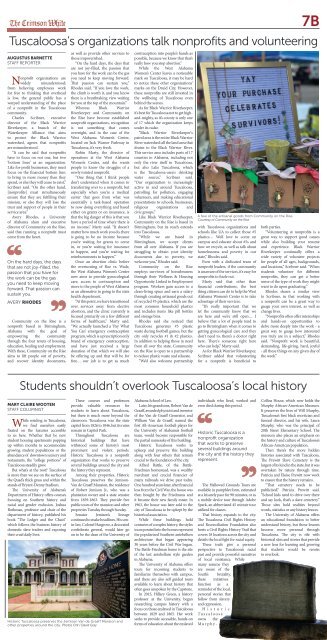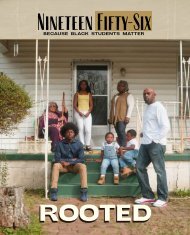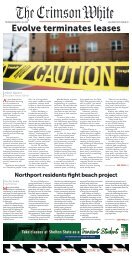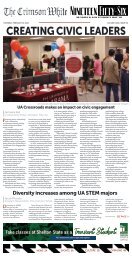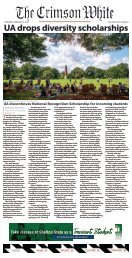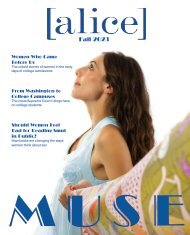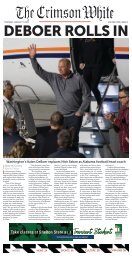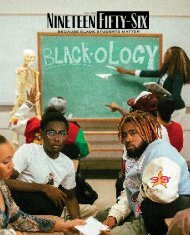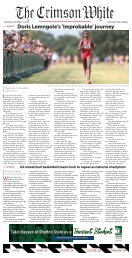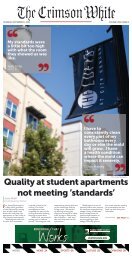The Crimson White Local Edition, Aug. 18, 2022
The Crimson White's first print edition of the fall 2022 semester celebrates the city of Tuscaloosa that UA students call home for four years. Click through to learn about the highlights and drawbacks of life in "Title-town".
The Crimson White's first print edition of the fall 2022 semester celebrates the city of Tuscaloosa that UA students call home for four years. Click through to learn about the highlights and drawbacks of life in "Title-town".
Create successful ePaper yourself
Turn your PDF publications into a flip-book with our unique Google optimized e-Paper software.
Students shouldn’t overlook Tuscaloosa’s local history<br />
7B<br />
Tuscaloosa’s organizations talk nonprofits and volunteering<br />
AUGUSTUS BARNETTE<br />
STAFF REPORTER<br />
Nonprofit organizations are<br />
widely misunderstood;<br />
from believing employees work<br />
for free to thinking that overhead<br />
is low, the general public has a<br />
warped understanding of the place<br />
of a nonprofit in the Tuscaloosa<br />
community.<br />
Charles Scribner, executive<br />
director of the Black Warrior<br />
Riverkeeper, a branch of the<br />
Waterkeeper Alliance that aims<br />
to protect the Black Warrior<br />
watershed, agrees that nonprofits<br />
are misunderstood.<br />
“It can be said that nonprofits<br />
have to focus on not one, but two<br />
‘bottom lines’ as an organization.<br />
Like for-profit businesses, they must<br />
focus on the financial bottom line:<br />
to bring in more money than they<br />
spend, or else they will cease to exist,”<br />
Scribner said. “On the other hand,<br />
[nonprofits] must simultaneously<br />
ensure that they are fulfilling their<br />
mission, or else they will lose the<br />
trust and support of people in their<br />
service area.”<br />
Avery Rhodes, a University<br />
of Alabama alum and executive<br />
director of Community on the Rise,<br />
said that running a nonprofit must<br />
come from the heart.<br />
On the hard days, the days<br />
that are not joy-filled, the<br />
passion that you have for<br />
the work can be the gas<br />
you need to keep moving<br />
forward. That passion can<br />
sustain you.<br />
AVERY RHODES<br />
Community on the Rise is a<br />
nonprofit based in Birmingham,<br />
Alabama with the goal of<br />
empowering the community<br />
through the four tenets of housing,<br />
education, healing and employment.<br />
With these, Community on the Rise<br />
aims to lift people out of poverty,<br />
and recover identity documents,<br />
as well as provide other services to<br />
those impoverished.<br />
“On the hard days, the days that<br />
are not joy-filled, the passion that<br />
you have for the work can be the gas<br />
you need to keep moving forward.<br />
That passion can sustain you,”<br />
Rhodes said. “If you love the work,<br />
the climb is worth it, and you know<br />
there is a breathtaking view waiting<br />
for you at the top of the mountain.”<br />
Whereas Black Warrior<br />
Riverkeeper and Community on<br />
the Rise have become established<br />
nonprofit organizations, recognition<br />
is not something that comes<br />
overnight, and in the case of the<br />
West Alabama Women’s Center,<br />
located on Jack Warner Parkway in<br />
Tuscaloosa, it’s very fresh.<br />
Robin Marty, the director of<br />
operations at the West Alabama<br />
Women’s Center, said she wants<br />
people to know the struggles of a<br />
newly minted nonprofit.<br />
“One thing that I think people<br />
don’t understand when it comes to<br />
transferring over to a nonprofit, but<br />
especially when you’re a medical<br />
center that goes from what was<br />
essentially a task-based operation<br />
to now doing everything and based<br />
either on grants or on insurance, is<br />
that the big danger of this is that you<br />
have a period of time where there is<br />
no income,” Marty said. “It doesn't<br />
matter how much work you do, there<br />
is going to be no income because<br />
you’re waiting for grants to come<br />
in, or you’re waiting for insurance<br />
to happen, and you’re waiting for<br />
reimbursements to happen.”<br />
Once an abortion clinic before<br />
the overturning of Roe vs. Wade,<br />
the West Alabama Women’s Center<br />
now aims to provide gynecological<br />
care, access to contraception and<br />
more to the people of West Alabama<br />
as an alternative to going to the state<br />
health department.<br />
“At this point, we have transitioned<br />
over services away from elective<br />
abortion, and the clinic currently is<br />
focused primarily on a few different<br />
forms of healthcare,” Marty said.<br />
“We actually launched a ‘Pay What<br />
You Can’ emergency contraception<br />
program, which is a prescription only<br />
brand of emergency contraception,<br />
and have just received a large<br />
donation of that which we will also<br />
be offering up and that will be for<br />
free… our job is to get as much<br />
contraception into people’s hands as<br />
possible, because we know that that’s<br />
really how you stop abortion.”<br />
While the West Alabama<br />
Women’s Center leaves a noticeable<br />
mark on Tuscaloosa, it may be hard<br />
to notice these other organizations’<br />
marks on the Druid City. However,<br />
these nonprofits are still invested in<br />
the wellbeing of Tuscaloosa even<br />
behind the scenes.<br />
As for Black Warrior Riverkeeper,<br />
it’s best for Tuscaloosa not to get highand-mighty,<br />
as it’s county is only one<br />
of 17 which the organization keeps<br />
under its radar.<br />
“Black Warrior Riverkeeper's<br />
patrol area is the entire Black Warrior<br />
River watershed: all the land area that<br />
drains to the Black Warrior River.<br />
This service area includes parts of 17<br />
counties in Alabama, including not<br />
only the river itself in Tuscaloosa,<br />
but also Lake Tuscaloosa, which<br />
is the Tuscaloosa-area's drinking<br />
water source,” Scribner said.<br />
“Our organization is increasingly<br />
active in and around Tuscaloosa,<br />
patrolling for pollution, engaging<br />
volunteers, and making educational<br />
presentations to schools, businesses,<br />
religious organizations and<br />
civic groups.”<br />
Like Black Warrior Riverkeeper,<br />
Community on the Rise is based in<br />
Birmingham, but its reach extends<br />
into Tuscaloosa.<br />
“While we are based in<br />
Birmingham, we accept clients<br />
from all over Alabama. If you are<br />
struggling to obtain your identity<br />
documents due to poverty, we<br />
welcome you,” Rhodes said.<br />
Community on the Rise<br />
employs survivors of homelessness<br />
through their Wellness & Housing<br />
Opportunity Linked to Employment<br />
program. Workers gain access to a<br />
clean-living space and earn a salary<br />
through creating artisanal goods out<br />
of recycled #5 plastics, which are the<br />
most common household plastics<br />
and includes items like pill bottles<br />
and storage bins.<br />
Rhodes said she noticed that<br />
Tuscaloosa generates #5 plastic<br />
waste during football games, but the<br />
city only recycles #1 & #2 plastics.<br />
In addition to helping those in need<br />
from all over the state, Community<br />
on the Rise is open to a partnership<br />
to reduce plastic waste and educate.<br />
“We’d also welcome partnership<br />
A few of the artisanal goods from Community on the Rise.<br />
Courtesy of Community on the Rise<br />
with Tuscaloosa organizations and<br />
schools like UA to collect those #5<br />
plastics… We’d love to come on<br />
campus and educate about #5s and<br />
how we recycle, as well as talk about<br />
homelessness and poverty in our<br />
state,” Rhodes said.<br />
Even with a dedicated team of<br />
nonprofit leaders, if the community<br />
is unaware of the services, it’s easy for<br />
nonprofits to fizzle out.<br />
Marty said that other than<br />
financial contributions, the best<br />
thing citizens can do to help the West<br />
Alabama Women’s Center is to take<br />
advantage of their services.<br />
“It’s really important that we<br />
let the community know that we<br />
are here and we’re still open… I<br />
believe that a lot of people tend to<br />
go to Birmingham when it comes to<br />
getting gynecological care and they<br />
don't need to, there’s a doctor right<br />
here. <strong>The</strong>re's someone right here<br />
who can help,” Marty said.<br />
As for Black Warrior Riverkeeper,<br />
Scribner added that volunteering<br />
for a nonprofit is beneficial to<br />
both parties.<br />
“Volunteering at nonprofits is a<br />
great way to support good causes<br />
while also building your resume<br />
and experience. Black Warrior<br />
Riverkeeper continually offers a<br />
wide variety of volunteer projects<br />
for people of all ages, backgrounds,<br />
and locations,” Scribner said. “When<br />
students volunteer for different<br />
nonprofits, they can get a better<br />
sense of the type of work they might<br />
want to do upon graduating.”<br />
Rhodes shares a similar view<br />
to Scribner, in that working with<br />
a nonprofit can be a great way to<br />
gauge your own interest, as well as<br />
change lives.<br />
“Nonprofits often offer internships<br />
and hands-on opportunities to<br />
delve more deeply into the work - a<br />
great way to gauge how interested<br />
you truly are in a subject,” Rhodes<br />
said. “Nonprofit work is beautiful,<br />
demanding, life-giving, hard, joyful<br />
- all these things on any given day of<br />
the week.”<br />
MARY CLAIRE WOOTEN<br />
STAFF COLUMNIST<br />
While residing in Tuscaloosa,<br />
we find ourselves easily<br />
fixated on the luxuries accessible<br />
to us here. Whether that be new<br />
student housing apartments popping<br />
up within months to accommodate<br />
growing student populations or the<br />
abundance of downtown scenery and<br />
restaurants, the “college portions” of<br />
Tuscaloosa steadily grow.<br />
But what’s at the root? Tuscaloosa<br />
is more than we see on the surface of<br />
the Quad’s thick grass and within the<br />
stands of Bryant-Denny Stadium.<br />
<strong>The</strong> University of Alabama’s<br />
Department of History offers courses<br />
focusing on Southern history and<br />
racial and gender exclusion. Joshua<br />
Rothman, professor and chair of the<br />
department of history, published his<br />
book “<strong>The</strong> Ledger and the Chain”<br />
which follows the business history of<br />
domestic slave traders and exposing<br />
their cruel daily lives.<br />
<strong>The</strong>se courses and professors<br />
provide valuable resources for<br />
students to learn about Tuscaloosa,<br />
but there is much more beyond the<br />
classroom. Tuscaloosa was the state<br />
capitol from <strong>18</strong>26 to <strong>18</strong>46, but its ruins<br />
remain in Capitol Park.<br />
Throughout Tuscaloosa are<br />
historical buildings that have<br />
withstood some of history’s most<br />
prominent and violent periods.<br />
Historic Tuscaloosa is a nonprofit<br />
organization that works to preserve<br />
several buildings around the city and<br />
the history they represent.<br />
Among their properties, Historic<br />
Tuscaloosa preserves the Jemison-<br />
Van de Graaff Mansion, the residence<br />
of Robert Jemison Jr., who was a<br />
plantation owner and a state senator<br />
from <strong>18</strong>59-<strong>18</strong>63. <strong>The</strong>y provide free<br />
public tours of the mansion and other<br />
properties Tuesday through Sunday.<br />
Senator Jemison’s lineage<br />
continued to make headlines. His sonin-law,<br />
Colonel Hargrove, a decorated<br />
confederate general, would later go<br />
on to be the dean of the University of<br />
Historic Tuscaloosa preserves the Jemison Van de Graaff Mansion and<br />
other properties around the city. Photos CW / David Gray<br />
Alabama School of Law.<br />
Later, his grandsons, Robert Van de<br />
Graaff, awarded physicist and inventor<br />
of the Van de Graaff Generator, and<br />
William Van de Graaff, named the<br />
first All-American football player for<br />
the University of Alabama’s football<br />
team, would become responsible for<br />
the partial namesake of this building.<br />
Historic Tuscaloosa works to<br />
upkeep and preserve this building<br />
along with four others that remain<br />
crucial to the foundation of the city.<br />
Alfred Battle, of the Battle-<br />
Friedman homestead, was a wealthy<br />
merchant and crucial financier of<br />
many railroads we drive past today.<br />
One hundred years later, after financial<br />
loss from the Civil War, the house was<br />
then bought by the Friedmans and<br />
it became their new family estate. In<br />
1963, the house was later sold to the<br />
city of Tuscaloosa to be upkept by the<br />
historical association.<br />
While these buildings hold<br />
centuries of complex history, the styles<br />
incorporated into the homes represent<br />
the popularized Southern antebellum<br />
architecture that began appearing<br />
30 years before the Civil War began.<br />
<strong>The</strong> Battle-Friedman home is the site<br />
of the last antebellum style garden<br />
in Alabama.<br />
<strong>The</strong> University of Alabama offers<br />
tours for incoming students to<br />
familiarize themselves with campus,<br />
and there are also self guided tours<br />
available to learn about history that<br />
often goes unspoken by the Capstone.<br />
In 2015, Hillary Green, a history<br />
professor at the University, began<br />
researching campus history with a<br />
focus on those enslaved in Tuscaloosa<br />
between <strong>18</strong>29 and <strong>18</strong>65. Her work<br />
seeks to provide accessible, hands-on<br />
forms of education about the enslaved<br />
individuals who lived, worked and<br />
even died during this period.<br />
Historic Tuscaloosa is a<br />
nonprofit organization<br />
that works to preserve<br />
several buildings around<br />
the city and the history they<br />
represent.<br />
<strong>The</strong> Hallowed Grounds Tours are<br />
available in pamphlet form, estimated<br />
at a leisurely pace for 90 minutes, or as<br />
a mobile device tour through Adobe<br />
Spark, an abbreviated 45 minute tour<br />
utilized for classes.<br />
That history expands to the city.<br />
<strong>The</strong> Tuscaloosa Civil Rights History<br />
and Reconciliation Foundation also<br />
hosts a Civil Rights History Trail that<br />
covers <strong>18</strong> locations across the city and<br />
details the local fight for racial equity.<br />
<strong>The</strong>se trails give a personal<br />
perspective to Tuscaloosa’s racial<br />
past and provide powerful narratives<br />
of local resistance. While<br />
many assume they<br />
are aware of the<br />
South’s brutality,<br />
these initiatives<br />
function as a<br />
reminder of the local,<br />
personal stories that<br />
follow from slavery<br />
and oppression.<br />
H i s t o r i c<br />
Tuscaloosa<br />
owns the<br />
Murphy-<br />
Collins House, which now holds the<br />
Murphy African-American Museum.<br />
It preserves the lives of Will Murphy,<br />
Tuscaloosa’s first black mortician and<br />
funeral director, and his wife, Laura<br />
Murphy, who was the principal of<br />
20th Street Elementary School. <strong>The</strong><br />
museum also places an emphasis on<br />
the history and culture of Tuscaloosa’s<br />
African-American population.<br />
<strong>The</strong>n there’s the more hidden<br />
histories associated with Tuscaloosa.<br />
<strong>The</strong> Prewitt Slave Cemetery is the<br />
largest of its kind in the state, but it was<br />
overtaken by nature through time.<br />
Patricia and Eloise Prewitt now work<br />
to ensure that the history remains.<br />
“That cemetery needs to be<br />
publicized,” Patricia Prewitt said.<br />
“School kids need to drive over there<br />
and say look, that’s a slave cemetery.”<br />
Those sites hold realities beyond<br />
words, statistics or any history lesson.<br />
<strong>The</strong> University of Alabama offers<br />
an educational foundation to better<br />
understand history, but those lessons<br />
become more personal through<br />
Tuscaloosa. <strong>The</strong> city is rife with<br />
historical sites and stories that provide<br />
a new lens for learning and growing<br />
that students would be remiss<br />
to overlook.


